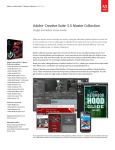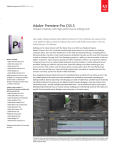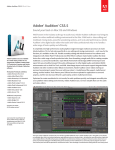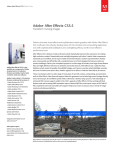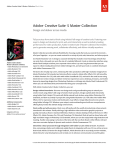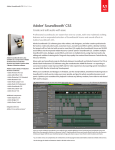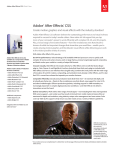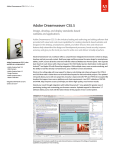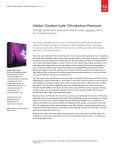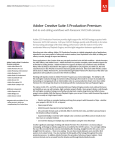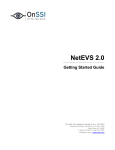Download Adobe Creative Suite 5.5 Production Premium, Win
Transcript
Adobe Creative Suite 5.5 Production Premium What’s New Adobe® Creative Suite® 5.5 Production Premium Create video for virtually any screen using high-performance production tools Experience a more efficient workflow thanks to sweeping productivity enhancements in Adobe Creative Suite 5.5 Production Premium, the complete software solution for video and post-production. Workflow improvements, powerful new audio editing capabilities, and new compositing effects and enhancements build upon the dramatic performance gains introduced with Adobe Creative Suite 5 Production Premium. Adobe Creative Suite 5.5 Production Premium combines full versions of: •Adobe® Premiere® Pro CS5.5 •Adobe After Effects® CS5.5 •Adobe Photoshop® CS5 Extended •Adobe Audition® CS5.5 •Adobe Flash® Catalyst® CS5.5 •Adobe Flash Professional CS5.5 •Adobe Illustrator® CS5 •Adobe OnLocation™ CS5 •Adobe Encore® CS5 Additional components: Adobe Dynamic Link Adobe Device Central CS5.5 Adobe Bridge CS5 Adobe Media Encoder CS5.5 Stay in the creative flow and deliver video to virtually any screen with Adobe Creative Suite 5.5 Production Premium software, the all-in-one solution for video and post-production that offers best-ofbreed tools for editing, animation, compositing, audio, and delivery. CS5.5 Production Premium accelerates your entire post-production workflow, building on the native 64-bit support that powered Adobe Premiere Pro CS5, After Effects CS5, and Photoshop CS5 software; Adobe Premiere Pro CS5.5 adds workflow efficiencies and expands GPU support. CS5.5 Production Premium also enhances the industry’s best file-based workflow, delivering true native editing of today’s DSLR video and digital cinema formats for both After Effects CS5.5 and Adobe Premiere Pro CS5.5. Tight integration streamlines your workflow further: move projects easily between Adobe Premiere Pro and other editing tools, and iterate quickly thanks to Dynamic Link between After Effects, Adobe Premiere Pro, and Adobe Encore. This potent combination of a comprehensive toolset, industry-leading performance, and extensive integration adds up to incomparable value. Starting from its battle-tested, high-performance foundation, the enhancements in CS5.5 Production Premium keep pace with your evolving production needs and with the new forms of delivery your clients may require, such as output to smartphones and tablets. With timesaving innovations that extend your creative options—from the Warp Stabilizer in Adobe After Effects CS5.5 to the more intuitive 64-bit Adobe Media Encoder—CS5.5 Production Premium packs lightning-fast speed and innovative creative tools that give you unprecedented creative freedom to craft great stories. Integrates with Adobe CS Live online services* † Subscription option Get the same product with low monthly payments. Please visit www.adobe.com/go/cssubscription to learn more. Adobe Premiere Pro CS5.5 (above) includes powerful editing-tool enhancements, dual-system sound support, and the faster-than-ever Adobe Mercury Playback Engine. After Effects CS5.5 (top right) features the new Warp Stabilizer for steadying handheld footage. The updated design of Adobe Media Encoder CS5.5 (right) makes it easy to monitor multiple background renders at a glance while you keep working in Adobe Premiere Pro, After Effects, and Encore. Top features •A smoother, more efficient editing workflow in Adobe Premiere Pro CS5.5 (Page 2) •Adobe Audition and integrated audio-for-video workflows on Mac OS and Windows® (Page 3) •Warp Stabilizer effect in After Effects (Page 4) •Enhanced Adobe Mercury Playback Engine for desktops and laptops (Page 5) •Faster, more reliable encoding to multiple screens with revamped Adobe Media Encoder (Page 5) •Expanded native support for RAW digital cinema and file-based workflows (Page 6) •Camera Lens Blur effect and camera property for realistic defocused blur (Page 7) •Direct Adobe Premiere Pro integration with Adobe Story (Page 8) •Light Falloff property in After Effects (Page 8) •Streamlined, integrated collaboration (Page 9) •Multi-target project setup in Flash Professional (Page 9) With Adobe Creative Suite 5.5 Production Premium, you can: Work faster. Adobe Creative Suite 5.5 Production Premium takes the breakthrough performance delivered in Creative Suite 5 and makes it more accessible; in Adobe Premiere Pro CS5.5, expanded support for mobile and desktop video cards brings Adobe Mercury Playback Engine GPU acceleration to a wider selection of systems, including Windows laptops for editing in the field. Edit with a highly efficient keyboard-driven workflow, and boost productivity with dual-system sound support and other timesaving features suggested by users. Adobe CS5.5 Production Premium gives you new flexibility when working with RAW digital cinema files and other file-based footage in After Effects CS5.5 and Adobe Premiere Pro CS5.5, building upon the industry’s best file-based workflow which eliminates transcoding and rewrapping while preserving the pristine quality of your footage. 64-bit Adobe Media Encoder CS5.5 simplifies multiscreen delivery—with new, intuitive presets and contextual menus that let you set up sequences once for batch encoding to multiple formats such as PCs, smartphones, and television, while you continue editing. Craft great stories with game-changing creative innovation. Adding to the groundbreaking Roto Brush feature that After Effects CS5 introduced, the new Warp Stabilizer gives you options for improving the quality of handheld footage; Camera Lens Blur lets you control which parts of a scene are in focus; and Light Falloff enables you to manage how light behaves in a 3D scene. Improve your audio workflow and get best-in-class editing and multitrack mixing tools, powerful sweetening options, and rock-solid performance using Adobe Audition CS5.5—available for the first time on Mac OS, as well as Windows. Collaborate efficiently. Easily integrate CS5.5 Production Premium with existing workflows, whether you’re part of a small workgroup or a large-scale enterprise. Move projects back and forth more easily between Adobe Premiere Pro and Adobe Audition, and other NLEs such as Apple Final Cut Pro. Adobe Story, an Adobe CS Live online service* † for collaborative script writing, now directly integrates with Adobe Premiere Pro and helps you create metadata-rich, production-ready assets. New presets in Adobe Media Encoder make it easier to send sequences to Adobe CS Review, another CS Live online service, making it easier for you to get feedback from clients and teammates on works in progress. Top new features of Adobe Creative Suite 5.5 Production Premium A smoother, more efficient editing workflow in Adobe Premiere Pro CS5.5 Building on the breakthrough performance delivered by Adobe Creative Suite 5 Production Premium, Adobe Premiere Pro CS5.5 brings new editing enhancements that save you time and help you meet daily post-production challenges. Merge Clips command for dual-system soundsupport Recording audio in the field with a dedicated sound recorder and high-quality, specialized microphones produces optimal sound for film and video production. This time-honored technique is now used to overcome the limitations of the microphones built into DSLR cameras that shoot HD video, and to capture audio for digital cinema cameras such as the RED ONE and Silicon Imaging SI-2K. Traditionally, the process of combining field audio with camera footage in post-production has been time-consuming and tedious. Using the new Merge The new Merge Clips dialog box in Adobe Clips feature in Adobe Premiere Pro CS5.5, you quickly Premiere Pro CS5.5 lets you quickly choose different sync references, so that audio and can create clips that combine separate audio and video video recorded on different devices can be source files. The Merge Clips dialog box lets you choose easily aligned for synchronized playback. In points and Out points, timecode, or a numbered clip marker as the sync reference. The ability to use In and Out points as sync references is essential when matching audio clips to video clips that were shot on DSLR cameras, which typically do not supply timecode without additional software or special plug-ins. Referencing a numbered clip Adobe Creative Suite 5.5 Production Premium What’s New 2 marker lets you sync clips based on an event that occurs somewhere in the middle of a shot—for example, the popping of a champagne cork. With the Merge Clips command, you can sync up to 16 audio clips to a single video clip. Standard NLE shortcuts If you’re experienced with nonlinear editing (NLE) systems but new to Adobe Premiere Pro, be productive and efficient right away by using keyboard presets based on widely accepted shortcuts for NLEs such as Avid Media Composer and Final Cut Pro. With the redesigned Keyboard Shortcuts dialog box you can customize keyboard shortcuts faster, and get easier access to updated keyboard layout presets for Avid Media Composer and Final Cut Pro-style shortcuts. You can also find clip, sequence, and In/Out markers more quickly using keyboard shortcuts that are now displayed in the Keyboard Shortcuts menu. Adobe Audition and integrated audio-for-video workflows on Mac OS and Windows Well known in the industry for its versatility and feature set, Adobe Audition is a state-of-the-art audio toolset that offers one-stop shopping for recording, editing, mixing, mastering, and sweetening. Adobe Audition now brings its audio-for-video multitrack editing environment to Mac OS and Windows as part of Adobe Creative Suite 5.5 Production Premium. Because of its professional editing and multitrack mixing tools, powerful noise-reduction and effects options, as well as super-fast performance, audio and video professionals rely on Audition to handle a wide range of tasks quickly and efficiently. Enjoy a smooth workflow with a fast new multiprocessor-powered audio engine and roundtrip editing. Exchange projects with popular digital audio workstations (DAWs) and other NLEs. Create entirely new surround sound experiences with native multichannel support and 5.1 surround sound. Take advantage of enhanced effects workflows as well as new audio effects such as DeHummer for hum removal, Surround Reverb tailored for 5.1 surround. View and edit XMP metadata, including broadcast WAV metadata, in the simplified XMP Panel, undo unwanted changes with the new History panel, and safeguard your work using the XML-based file format. A completely new high-performance audio engine takes full advantage of multicore processors to make Adobe Audition CS5.5 an even more powerful all-in-one editing and mixing environment. Roundtrip audio workflow between Adobe Audition and Adobe Premiere Pro Adobe Premiere Pro CS5.5 offers roundtrip integration with Adobe Audition CS5.5. With the new Edit In Adobe Audition command in Adobe Premiere Pro, you can send individual clips or sequences, including reference videos, directly to Adobe Audition for audio editing and restoration. Adobe Creative Suite 5.5 Production Premium What’s New 3 Extend your desktop workflow A recent update to Adobe Photoshop CS5 and Photoshop CS5 Extended software opens the door for communication via wifi between this industry-leading digital imaging software and apps on popular device platforms like Android, BlackBerry, and iOS.‡ To learn more about the first apps to take advantage of this new connectivity, visit www. photoshop.com/products/mobile. Audio edits you apply in Adobe Premiere Pro such as effects and clip volume metadata can be rendered when you move a clip or sequence to Audition, so you can begin a rough audio cut in Adobe Premiere Pro and polish it in Adobe Audition. Collaboration with dedicated audio post-production specialists often requires working with Avid ProTools and other NLEs. As a cross-platform tool with OMF and XML Interchange compatibility, Audition can add power and depth to virtually any production environment by saving project files to and importing them from NLEs and DAWs such as Apple Final Cut Pro and Avid Pro Tools. You can send Adobe Premiere Pro clips and sequences to Adobe Audition for advanced audio editing and restoration, then roundtrip back to Adobe Premiere Pro. Like Adobe Premiere Pro, Audition can exchange projects with Final Cut Pro and other NLEs, to simplify integration with larger workflows. Warp Stabilizer effect in After Effects In professional video productions, handheld cameras are commonly stabilized with hardware such as a Steadicam. However, with video cameras appearing in more diverse and versatile forms—from mobile phones to sports helmet cameras and digital SLRs—it isn’t always practical or affordable to use a professional camera stabilizer. While image stabilization features can be found in other video production software, they typically correct camera position only, betraying the fact that the footage was originally handheld, and resulting in artifacts that compromise the quality of the footage. In the new Warp Stabilizer, After Effects takes an innovative approach to removing camera shake called Subspace Warp. Going beyond stabilizing just camera position, the new Subspace Warp option uses advanced pixel analysis to also correct camera rotation, rolling shutter artifacts, and parallax effects. The resulting stabilized clip can make handheld footage appear as steady and smooth as if shot from a camera mounted on a mechanical stabilizer. ‡ Photoshop CS5 or Photoshop CS5 Extended (version 12.0.4 or later) and wireless Internet connection required. Mobile and tablet applications require a separate download and agreement to additional terms. Such applications may not be available in all countries or languages and may be subject to change or discontinuation without notice. Additional fees or subscription charges may apply. After Effects displays a frame overlay to show that it’s automatically analyzing the shot—the first step in stabilization. You can see a preliminary result in just one step: Apply Warp Stabilizer to the source layer, and let After Effects perform analysis and stabilization. Analysis begins automatically without having to set tracking points or make any decisions whatsoever. Stabilization progress is displayed onscreen in two steps, first analyzing and then stabilizing. When the second step is complete, you can review the result immediately. Adobe Creative Suite 5.5 Production Premium What’s New 4 The Warp Stabilizer effect gives you a significant amount of control. Choose the default Subspace Warp method to correct Perspective, Position and Scale—or choose other options to correct various combinations of Position, Scale, Rotation, and Perspective. You can also control how the Warp Stabilizer effect resolves empty space that results at the edge of the frame when the stabilizing process repositions or transforms the image, by setting a threshold for automatically cropping the frame or by letting the effect intelligently fill empty spaces using information in adjacent frames. Warp Stabilizer offers considerable control over the automated result without creating actual keyframes in the timeline. The Subspace Warp option, chosen by default, performs pixel analysis to correct for motion artifacts including parallax shifts. 64-bit operating system required Enhanced Adobe Mercury Playback Engine for desktops and laptops Adobe Premiere Pro CS5.5 and After Effects CS5.5 run only on 64-bit operating systems, such as Mac OS X 10.5 or later, Microsoft® Windows Vista®64-bit Edition, or Windows 7 64-bit Edition. Adobe Media Encoder supports both 64-bit and 32-bit versions of Windows, and like both After Effects and Adobe Premiere Pro, is 64-bit only on Mac OS X. For more information about optimizing performance, see the complete system requirements on the last page of this document. The native 64-bit, multicore, GPU-accelerated Adobe Mercury Playback Engine in Adobe Premiere Pro is acclaimed for its real-time playback of multi-layer mixed-format timelines. In Adobe Premiere Pro CS5.5, the Adobe Mercury Playback Engine adds more GPU-accelerated effects and transitions, and also adds support for additional NVIDIA graphics cards, including mobile video cards for Windows.‡ For a current list of supported video cards, visit http://www.adobe.com/ go/64bit. Support for mobile graphics cards means that you can benefit from the performance enhancements of GPU acceleration on a laptop wherever you need to work—on location, on set, or when traveling. CUDA Accelerated The Adobe Mercury Playback Engine works hand in hand with NVIDIA CUDA technology, which leverages the parallel compute engine in NVIDIA GPUs to solve many complex computational problems in a fraction of the time it would take for a CPU to perform the same task. For a current list of supported video cards, visit http://www.adobe.com/go/64bit. Faster, more reliable encoding to multiple screens with revamped Adobe Media Encoder Reaching audiences wherever they are and on whatever device they wish to use to view video is an essential requirement of video production today. Optimized for performance, 64-bit Adobe Media Encoder is completely redesigned to deliver Adobe Premiere Pro video sequences, After Effects compositions, and Encore projects to multiple formats quickly, simply, and in the background. You can still export directly from Adobe Premiere Pro or render from After Effects using the Render Queue, but with Adobe Media Encoder you can maintain your creative momentum by continuing to work in other applications as your projects render in the background. Set up for encoding by simply dragging an item into the Adobe Media Encoder window. Next, simply choose from clearly labeled presets designed for common types of video output, including the web and smartphones. Of course, you can customize the presets to meet your requirements. Helpful contextual menus make it easy to inspect or edit items in the Queue. Once you start the Queue, Adobe Media Encoder quickly encodes your sequence in the background, taking advantage of multiple CPU cores. There’s no need for you to keep an eye on Adobe Media Encoder; it can play specific alert sounds to indicate when a render completes successfully or not. You’re free to concentrate on editing while Adobe Media Encoder works behind your other applications. Adobe Premiere Pro CS5 5.0.3 introduced support for mobile graphics cards in Windows. ‡ Adobe Creative Suite 5.5 Production Premium What’s New 5 To make it easier to output your work to virtually any video and device format, the new Adobe Media Encoder user interface includes three sections—the Queue pane, the Current Encode pane, and the Watch Folders pane. The batch queue at the top shows you the status of multiple renders, while the Current Encode pane displays details of the job that’s currently processing. This updated design makes it easy to monitor multiple background renders at a glance while you continue working in Adobe Premiere Pro, After Effects, and Encore. Adobe Media Encoder supports a wide range of output formats, including FLV, F4V, Windows Media, QuickTime, and other popular codecs such as MPEG-2, MPEG-4, H.264, and—new for Adobe Media Encoder CS5.5—AVC-Intra and DPX. Automate your workflow further using watch folders, new in Adobe Media Encoder CS5.5. You can configure watch folders with different encoding settings, so that encoding a clip to multiple destinations is as easy as dropping it in a preconfigured watch folder. Edit file-based media right away thanks to native support With native support for file-based media, you can begin editing virtually any video format—no transcoding or rewrapping—including DV, HDV, RED, DPX, Sony XDCAM, XDCAM 50, XDCAM EX and XDCAM HD, Panasonic P2, DVCPRO HD, AVCHD, and AVC-Intra. Edit video from DSLR cameras, including the Canon 5D Mark II and 7D, Nikon D90, D300s, D3000, and others. Expanded native support for RAW digital cinema and file-based workflows Building on its industry-leading native support of file-based media, CS5.5 Production Premium expands the flexibility of your workflow when working with RAW digital cinema files and other file-based footage in Adobe Premiere Pro CS5.5 and After Effects CS5.5. Now you have new options for adjusting RED source settings right in Adobe Premiere Pro CS5.5 and After Effects CS5.5.§ These settings help make CS5.5 Production Premium an even better choice for on-site workflows and dailies when working with RED content, because they offer deep control over crucial color settings. In addition to the ability to save and load the latest versions of RMD—as well as the ability to create custom presets—you can now pick a white point and use either a histogram or a five-point curves interface to adjust red, green, blue, RGB, or Luma values for a clip. You can choose which Color Science version is used, and FLUTs, Lift, Gamma, and Gain settings are all now supported. Adobe Premiere Pro CS5.5 and After Effects CS5.5 offer additional enhancements to improve your overall RED workflow, including the timesaving ability to apply source settings to multiple clips. Additionally, when you open the redesigned RED Source Settings dialog box, it remembers which options you displayed in the previous session. Adobe Premiere Pro CS5.5 also offers enhanced native support for Canon XF footage. Now you can view Canon XF files—including spanned clips—in the Adobe Premiere Pro Media Browser, preview XF footage in the Project panel, view and edit camera metadata in the Metadata panel, and take advantage of metadata throughout your pre- and post-production workflows. In After Effects, you can now import CinemaDNG files and export XDCAM-EX footage. § Adobe Premiere Pro CS5 5.0.2 included enhancements for the RED Rocket card and Color Science, and introduced support for exporting in XDCAM-HD format. After Effects CS5 10.0.1 added support for RMD and RED file formats. Adobe Creative Suite 5.5 Production Premium What’s New 6 View and edit color settings and metadata in RED footage using the enhanced Source Settings dialog box. Camera Lens Blur effect and camera property for realistic defocused blur Camera lens blur re-creates in post-production the abstract and often visually appealing characteristics that appear in the defocused areas of a camera image. With this effect, footage shot in perfect focus can take on the elegant visual attributes of a soft-focus image. You can apply this look with the new Camera Lens Blur effect or generate it automatically using the Depth of Field controls in an After Effects camera. In soft-focus areas, Camera Lens Blur creates edge halos in the shape of the iris blades, just as a real, defocused camera lens does. When you choose an iris shape (from triangle up to decagon, representing the number of blades), additional options appear so that you can specify the exact characteristics of the iris. What is bokeh? “Bokeh” is a term originally coined in Japan for the qualities of defocused light areas as seen through a lens. Points of light become “circles of confusion”—bright disks that take on the shape of the camera iris—as seen in many cinematic night shots. Although occasionally regarded as a flaw, bokeh is more often viewed as a lovely and desirable way to introduce visual interest using shallow depth of field. Bokeh blur is the natural result when light highlights appear in the defocused area of an image, but many blur features don’t account for this. The depth-of-field effects on the right bring focus to the face by making the foreground appear defocused. While Camera Lens Blur is a layer effect, you can also apply the same attributes to After Effects cameras for more realistic depth-of-field effects when creating 3D compositions. In a 3D layer, you can animate Camera Lens Blur properties such as Aperture and Distance to perform rack focusing in 3D space. With the Camera Lens Blur effect, you can also create computer-generated elements that composite more convincingly with live-action footage. Adobe Creative Suite 5.5 Production Premium What’s New 7 Enabling depth-of-field blur with the After Effects camera activates camera blur controls, such as the Highlight option with Gain and Threshold parameters and the Iris option with a Shape parameter. The amount of blur is determined by the focus distance and aperture settings, like an actual lens. In a 2D scene, you can apply a separate layer as a grayscale map to create depth-of-field effects, or apply the effect without a map to defocus the entire scene equally. You can create rack focus effects by adjusting the focal distance setting, converting whichever channel values you specify to grayscale values that correspond to depth. You can use such a map to simulate other types of shallow focus, such as that of a tilt-shift lens. Direct Adobe Premiere Pro integration with Adobe Story In Adobe Premiere Pro CS5.5, you can move through the production pipeline more quickly thanks to direct integration with Adobe Story, an Adobe CS Live online service* † that serves as a blueprint for creative narratives. You can now import Adobe Story scripts into Adobe Premiere Pro without first going through Adobe OnLocation. Learn about the newest features of CS Live online services,* † which are complimentary until April 12, 2012. Visit www.adobe.com/go/cslive for details. You can transfer script metadata, such as scene location, character names, and dialogue to a clip’s XMP metadata in Adobe Premiere Pro. In the Project panel in Adobe Premiere Pro, enter scene numbers for clips that match scene numbers in the story script, and batch-transfer this data to the clip at the click of a button. This helps eliminate hours of routine work by enabling you to effortlessly locate all takes of a specific shot, or search dialogue, scene locations, and character names. Because scripts are embedded as metadata and preserved throughout a project, you can take Embedded Adobe Story scripts are displayed in the Adobe Premiere Pro CS5.5 Metadata panel, making it advantage of the metadata from production all easy to tell which clips have a script attached to them. the way to delivery. When you deliver a project as a web DVD using Adobe Encore, the script metadata makes the web DVD content searchable. Light Falloff property in After Effects In the real world, light intensity diminishes naturally the further objects are from the light source. After Effects now gives you the controls you need to simulate natural illumination falloff in a 3D scene—or create other light intensity effects, if so desired. Choose the Inverse-Square falloff setting to re-create the real-world decay of light over distance, in which light intensity naturally falls off by the square of the inverse distance. The smooth falloff setting lets you specify the exact distance over which light levels decay. With either setting, you can determine at what distance (in pixels) light falloff starts and ends. The same four basic choices of light type previously offered in After Effects—Parallel, Spot, Point, and Ambient—all remain, with each type (except Ambient, Adobe Creative Suite 5.5 Production Premium What’s New 8 which is equal at all positions and thus does not decay) supporting both types of falloff. You can mix light types, intensities, and shadow casting settings the same way you could in previous releases of After Effects. Inverse-square lighting falls off naturally, displaying characteristics of real-world light. Streamlined, integrated collaboration Move more quickly through project reviews and improve communication with colleagues and clients thanks to collaboration enhancements in Adobe Creative Suite 5.5 Production Premium. More efficient video reviews To save bandwidth and storage space, new presets in Adobe Media Encoder CS5.5 let you control the quality of video files that you export for a team review in CS Review. Enhanced collaboration with Adobe Story* † Manage collaborative review sessions more efficiently among team members when using the sharing and reviewing tools in Adobe Story,* † a CS Live online service that now integrates directly with Adobe Premiere Pro. Email Notifications, Track and Review Changes, and History allow you to stay current with script changes while also assigning editing privileges, inviting other team members to review and collaborate, and rolling back to past edited versions to see the progress of your script. Enhanced roundtrip editing with Apple Final Cut Pro Adobe Device Central Adobe CS5.5 Production Premium includes Adobe Device Central CS5.5, which simplifies the production of innovative and compelling content for smartphones and other consumer electronic devices. Save time by automating testing and simulating accelerometer, geolocation, multitouch, and network performance of mobile content across a dynamically updated library of device profiles. Now with support for WebKit, HTML5, and the latest versions of Adobe Flash Player software, Adobe Device Central CS5.5 helps creative professionals and developers deliver engaging experiences to millions of mobile subscribers and consumers of content on many devices. When sharing media and sequences between Adobe Premiere Pro and Final Cut Pro or Avid NLEs, you get welcome workflow flexibility with improved integration, no matter which platform you’re using. Improved roundtrip editing capabilities with Apple Final Cut Pro make it easier to collaborate on projects in which teammates, clients, or other production facilities utilize a variety of editing and post-production software tools. For example, when you import and export project files between Adobe Premiere Pro CS5.5 and Final Cut Pro, you can adjust the volume on Stereo As Mono clips, and adjust the scaling of a clip when its pixel aspect ratio (PAR) is different from that of the sequence. Additionally, you can export clips that have been modified by the 3-Way ColorCorrector, retaining approximate settings, which helps to eliminate guesswork associated with manually re-creating color-correction results that previously did not transfer with the media asset. Multi-target project setup in Flash Professional Digital content now permeates a full range of viewing experiences, including smartphones, personal computers, and Internet-enabled televisions. With the new multiple-target management features in Flash Professional CS5.5, you can create Flash content once and deploy it virtually anywhere. Mobile device support includes Adobe Flash Player, Android™, iOS, and Adobe AIR®. Targeting multiple devices means you have to manage multiple FLA files for a single project. This process is streamlined in Adobe Flash Professional CS5.5 so that you can deploy content seamlessly across platforms and devices. For example, Flash Professional CS5.5 now includes 20 new code snippets for mobile devices. You can efficiently create, test, package, and deploy content for a wide range of screens and devices with Adobe Device Central. Other features that support multi-target projects are the ability to resize content on the stage, the ability to rasterize symbols, a streamlined Publish Settings dialog box, and seamless mobile testing. Adobe Creative Suite 5.5 Production Premium What’s New 9 Still using Adobe Creative Suite 4 Production Premium or earlier? If you’re considering upgrading to CS5.5 Production Premium, remember that you’ll benefit from all of the new features described in this paper, as well as all of the features introduced in CS5 Production Premium. They include: • Breakthrough performance. Work fluidly on HD and higher resolution projects with native 64-bit support in Adobe After Effects, Photoshop CS5 Extended, and Adobe Premiere Pro. The Adobe Mercury Playback Engine speeds up effects processing and rendering in Adobe Premiere Pro. • The industry’s best file-based workflow. Expanded native support for file-based media formats from AVCHD, XDCAM, AVC-Intra, and RED to the latest DSLR video formats makes the industry’s best file-based workflow even better. Edit native file-based footage immediately after transferring it from the camera, avoiding transcoding or rewrapping of footage. You save valuable time and preserve the pristine quality of the original capture along with camera metadata. • Eye-popping 3D and natural painting. In Photoshop Extended, easily extrude 3D assets from 2D layers, create expressive digital paintings, and quickly remove unwanted objects from complex backgrounds, thanks to 3D and enhanced painting capabilities and Content Aware Fill. • Roto Brush for fast isolation of moving foreground elements. Quickly and automatically separate a foreground object, such as an actor, from its current background so that it can be placed in a completely different environment. Simply brush paint strokes inside the foreground object and let After Effects determine where the subject starts and ends in each frame. • Cutting-edge storytelling with Adobe Story.* † Adobe Story, a CS Live online service, is a collaborative scriptwriting and outline tool that helps accelerate the process of turning your video projects into finished media. Craft your narratives from virtually anywhere in a safe offline or online writing environment. Collaboratively co-write and edit with your colleagues. • CS Live online services.* † In addition to Adobe Story, take advantage of integration with more services that support creative and production tasks among workgroups, whether colleagues are near or far. CS Live online services are designed to support production and post-production workflows; for example, you can gather feedback with CS Review and share project information with Acrobat.com. • Easy online portfolios with Flash Catalyst. Create online video portfolios and other types of expressive interactive content without writing code. There’s no need to learn scripting—simply design your vision using Illustrator or Photoshop Extended, and then bring layered media from those components into Flash Catalyst to add interactions using its approachable user interface. It’s easy to add video, sound effects, and dynamic media too. For more information Get detailed descriptions about the new features in each Adobe Creative Suite 5.5 Production Premium component by reviewing the What’s New overview for each component at www.adobe.com/products/ creativesuite/production. • Richer, more compatible interactive content in Flash Professional. An advanced text engine added in CS5 Production Premium provides much richer typography, including threaded text blocks, columns, precise creative control, and compatibility with text from other components such as Adobe Illustrator. Using the Spring option for the Bones tool in Flash Professional, you can design more realistic-looking inverse kinematics (IK) motion for jointed, flexible objects. • Perspective drawing in Adobe Illustrator. Draw shapes and scenes in accurate 1, 2, or 3-point linear perspective with perspective grids in Adobe Illustrator CS5. The Perspective Selection tool lets you move, scale, duplicate, and transform objects and live text dynamically in perspective. • Countless small improvements that make a big difference. Experience a smoother day-to-day workflow, thanks to user requests that sparked dozens of enhancements made throughout Production Premium. For more information, see Adobe Creative Suite 5 Production Premium What’s New. About Adobe Systems Incorporated Adobe is the world’s leading provider of software solutions to create, manage, and deliver highimpact, reliable digital content. For more information, visit www.adobe.com. Adobe Creative Suite 5.5 Production Premium What’s New 10 System requirements Mac OS Windows •Multicore Intel® processor with 64-bit support •64-bit support required: Intel® Pentium® 4 or AMD Athlon® 64 processor (Intel Core™ i3, i5, or i7 or AMD Phenom® II recommended); Intel Core 2 Duo or AMD Phenom II required for Adobe Premiere Pro •Mac OS X v10.5.8 or v10.6.3; Mac OS X v10.6.3 required for GPUaccelerated performance in Adobe Premiere Pro •2GB of RAM (4GB or more recommended) •20.6GB of available hard-disk space for installation; additional free space required during installation (cannot install on a volume that uses a case-sensitive file system or on removable flash storage devices) •1280x900 display (1280x1024 recommended) with qualified hardware-accelerated OpenGL graphics card, 16-bit color, and 256MB of VRAM •Adobe-certified GPU card for GPU-accelerated performance in Adobe Premiere Pro; visit www.adobe.com/go/premiere_systemreqs for the latest list of supported cards •64-bit operating system required: Microsoft® Windows Vista® Home Premium, Business, Ultimate, or Enterprise with Service Pack 1 (Service Pack 2 recommended) or Windows® 7 • 2GB of RAM (4GB or more recommended) •16.3GB of available hard-disk space for installation; additional free space required during installation (cannot install on removable flash storage devices) •1280x900 display (1280x1024 recommended) with qualified hardware-accelerated OpenGL graphics card, 16-bit color, and 256MB of VRAM •Some GPU-accelerated features in Adobe Photoshop Extended require graphics support for Shader Model 3.0 and OpenGL 2.0 •Adobe-certified GPU card for GPU-accelerated performance in Adobe Premiere Pro; visit www.adobe.com/go/premiere_systemreqs for the latest list of supported cards •7200 RPM hard drive for editing compressed video formats; RAID 0 for uncompressed •Some GPU-accelerated features in Adobe Photoshop® Extended require graphics support for Shader Model 3.0 and OpenGL 2.0 •Core Audio–compatible sound card • Some features in Adobe Bridge rely on a DirectX 9–capable graphics card with at least 64MB of VRAM •DVD-ROM drive compatible with dual-layer DVDs (SuperDrive for burning DVDs; Blu-ray burner for creating Blu-ray Disc media) •Java™ Runtime Environment 1.5 or 1.6 •QuickTime 9 software required for QuickTime features • Adobe Flash® Player 10 software required to play back DVD projects exported as SWF files •Broadband Internet connection required for online services and to validate Subscription Edition (if applicable) on an ongoing basis † For updates to system requirements and more detailed information about video hardware compatibility, visit www.adobe.com/go/production_systemreqs. • 7200 RPM hard drive for editing compressed video formats; RAID 0 for uncompressed •Adobe-certified card for capture and export to tape for SD/HD workflows •OHCI-compatible IEEE 1394 port for DV and HDV capture, export to tape, and transmit to DV device •Sound card compatible with ASIO protocol or MME/WDM • DVD-ROM drive compatible with dual-layer DVDs (DVD+-R burner for burning DVDs; Blu-ray burner for creating Blu-ray Disc media) • Java™ Runtime Environment 1.5 (32 bit) or 1.6 •QuickTime 9 software required for QuickTime features •Adobe Flash® Player 10 software required to play back DVD projects exported as SWF files •Broadband Internet connection required for online services and to validate Subscription Edition (if applicable) on an ongoing basis † For updates to system requirements and more detailed information about video hardware compatibility, visit www.adobe.com/go/production_systemreqs. Expected ship date Second quarter 2011 For more information Product details: www.adobe.com/products/ creativesuite/production * CS Live online services are complimentary until April 12, 2012. See www.adobe.com/go/CSLive for details. Adobe online services, including Adobe CS Live Services, are available only to users 13 and older and require agreement to additional terms and Adobe’s online privacy policy (available at www.adobe.com/go/terms). Online services are not available in all countries or languages, may require user registration and may be subject to change or discontinuation without notice. Additional fees or subscription charges may apply. † Adobe Systems Incorporated 345 Park Avenue San Jose, CA 95110-2704 USA www.adobe.com Adobe, the Adobe logo, Acrobat, Adobe AIR, Adobe Audition, Adobe OnLocation, Adobe Premiere, After Effects, AIR, Creative Suite, Encore, Flash, Flash Catalyst, Illustrator, and Photoshop are either registered trademarks or trademarks of Adobe Systems Incorporated in the United States and/or other countries. AMD Athlon and AMD Phenom are trademarks or registered trademarks of Advanced Micro Devices, Inc. Apple and Mac OS are trademarks of Apple, Inc., registered in the U.S. and other countries. Android is a trademark of Google, Inc. Intel, Intel Core, and Pentium are trademarks of Intel Corporation in the U.S. and other countries. Microsoft, Windows, and Windows Vista are either registered trademarks or trademarks of Microsoft Corporation in the United States and/or other countries. Java is a trademark or registered trademark of Oracle and/or it’s affiliates. All other trademarks are the property of their respective owners. © 2011 Adobe Systems Incorporated. All rights reserved. 2/11













